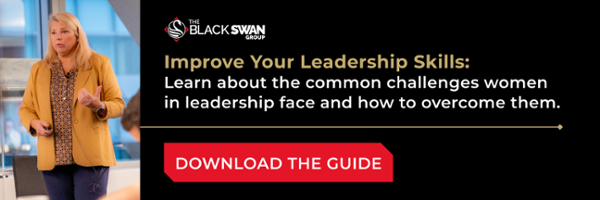When it comes down to it, leadership is leadership, and all leaders should approach it the same way. And yet, women can have a difficult time as leaders, particularly when supervising a group of men.
Keep reading to learn about four characteristics that women with good leadership skills exhibit so you can add them to your arsenal and enjoy better business outcomes.
1. The Right Mindset
Because women in leadership are often underestimated and looked down upon—especially in male-dominated fields—some assume their direct reports will have a problem with them simply because they are women. When something goes wrong, they hide behind this idea: You’re just saying that because I’m a woman!
But often, direct reports aren’t having problems because their superior is a woman. The problems usually lie in the guidance (or lack thereof) the supervisor gives the team.
If this sounds familiar to you, renegotiate your mindset and focus on using Tactical Empathy™ to achieve trust-based influence. To do that, you need to stay curious and demonstrate that you genuinely care about what your employees are going through every day.
2. Guiding vs. Micromanaging
Stereotypes tell us that women are supposed to be motherly, so some female leaders make a conscious effort to act the opposite. Instead of nurturing their employees, they act tough and try to micromanage every aspect of the job. This comes from the belief that being calm and nurturing is a sign of weakness, so they strongarm their subordinates to take control.
If you’re a rookie cop and have a sergeant following you around and controlling every movement you make, how do you think you will respond in a crisis scenario? Would your intuition kick in? Or would you be looking over your shoulder, waiting for the sergeant to tell you what to do? Making your employees fully dependent on you can establish a counterproductive environment.
Instead of being a micromanager, embrace a more nurturing approach and use Labels™ to guide your team to action: It seems like you might have an idea of how to handle this situation.
Don’t lead with an iron fist—rule with a velvet glove instead.
3. Ability to Address the Negatives
When effective female leaders start new positions—especially in male-dominated industries—they should understand that they are in a negotiation on the first day. Their direct reports may be harboring negative sentiments about the new work situation, so these women need to take a proactive approach by launching into an Accusation Audit™.
The AA™ might start like this: You may be uncomfortable with the fact that your new supervisor is a woman.
When you confront these negative sentiments right off the bat and speak to your new team’s fears, you convey that you understand what they may be feeling, making it that much easier to achieve trust-based influence.
4. Confidence vs. Arrogance
As a new leader, you need to come to terms with the fact that your team will attack you. You need to expect that this will happen and not feed into it.
Rather than responding with arrogance to these attacks, project confidence instead. An easy way to do that is by listening more than you speak and responding in a way that lets your team members know they are heard. Using Labels and Mirrors™ can be particularly helpful here.
At the end of the day, you need to accept that you will not have an answer for everything. Often, people think that not knowing something makes them look weak. However, admitting when you don’t know the answer projects honesty and openness. By being a calm person who is not afraid to admit your shortcomings, you exude strength, and your team will go to battle for you every day because of it.
It takes time to develop good leadership skills!
No new leader knocks it out of the park on the first day. To increase the chances you become an effective leader, the best thing you can do is show genuine interest in the people who work for you. Make sure the focus is on them—not you—and great things will happen.
To continue learning how to adopt good leadership skills, check out Women in Leadership: 4 Challenges and How to Overcome Them.



